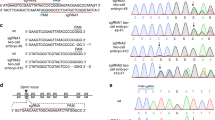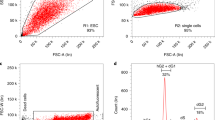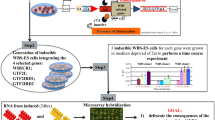Abstract
SEVERAL mouse gene families related to Drosophila developmental control genes and containing a homoeobox, a paired box or a finger domain, have been cloned and structurally analysed. On the basis of structural similarities to the Drosophila genes and of their spatially and temporally restricted expression patterns during mouse embryogenesis, it has been proposed that these mammalian genes also are involved in the control of develop-ment1–4. To elucidate the function of homoeobox genes by genetic means, mouse mutants must be generated. We have developed a technique for mutagenesis in vivo and have used it to mutate the homoeobox Hox 1.1 gene. In vivo mutagenesis was achieved through homologous recombination between an endogenous Hox 1.1 allele and a microinjected mutated gene in pluripotent embryonic stem (ES) cells5–9. Mutant cells were identified by means of the polymerase chain reaction (PCR) 10 and mutant clones were used to generate chimaeric mice. Because the homologous recombi-nation event is formally a gene conversion event and no selection is required to screen for cells carrying the mutated allele, in vivo mutagenesis allows specific alterations in the target sequence to be made without the introduction of any other sequences.
This is a preview of subscription content, access via your institution
Access options
Subscribe to this journal
Receive 51 print issues and online access
$199.00 per year
only $3.90 per issue
Buy this article
- Purchase on Springer Link
- Instant access to full article PDF
Prices may be subject to local taxes which are calculated during checkout
Similar content being viewed by others
References
Dressler, G. R. & Gruss, P. Trends Genet 4, 214–219 (1988).
Holland, P. W. H. & Hogan, B. L. M. Genes Dev. 2, 773–782 (1988).
Evans, R. M. & Hollenberg, S. M. Cell 52, 1–3 (1988).
Balling, R., Deutsch, U. & Gruss, P. Cell 55, 531–535 (1988).
Martin, G. Proc natn. Acad Sci U.S.A. 78, 7634–7638 (1981).
Bradley, A., Evans, M., Kaufmann, M. H. & Robertson, E. Nature 309, 255–256 (1984).
Doetschmann, T. C., Eistetter, M., Katz, M., Schmidt, W. & Kemler, R. J. J. Embryol. exp. Morph. 87, 27–45 (1985).
Robertson, E., Bradley, A., Kuehn, M. R. & Evans, M. J. Nature 323, 445–448 (1986).
Gossler, A., Doetschmann, T., Korn, R., Serfling, E. & Kemler, R. Proc. natn. Acad. Sci. U.S.A. 83, 9065–9069 (1986).
Saiki, R. K. et al. Science 239, 487–491 (1988).
Thomas, K. R. & Capecchi, M. R. Cell 51, 503–512 (1987).
Doetschmann, T. et al. Nature 330, 576–578 (1987).
Capecchi, M. R. Cell 22, 479–488 (1980).
Letson, A. & Liskay, R. M. Genetics 117, 759–769 (1987).
Colberg-Poley, A. M., Voss, S. D., Chowdhury, K. & Gruss, P. Nature 314, 713–717 (1985).
Kessel, M., Schulze, F., Fibi, M. & Gruss, P. Proc. natn. Acad. Sci. U.S.A. 84, 5306–5310 (1987).
Rudnicki, M. A. & McBurney, M. W. in Teratocarcinomas and Embryonic Stem Cells (ed. Roberston, E. J.) 19–49 (IRL, Oxford, 1987).
Smithies, O., Gregg, R. G., Boggs, S. S., Koralewski, M. A. & Kucherlapati, R. S. Nature 317, 230–234 (1985).
Thomas, K. R., Folger, K. R. & Capecchi, M. R. Cell 44, 419–428 (1986).
Author information
Authors and Affiliations
Rights and permissions
About this article
Cite this article
Zimmer, A., Gruss, P. Production of chimaeric mice containing embryonic stem (ES) cells carrying a homoeobox Hox 1.1 allele mutated by homologous recombination. Nature 338, 150–153 (1989). https://doi.org/10.1038/338150a0
Received:
Accepted:
Issue Date:
DOI: https://doi.org/10.1038/338150a0
This article is cited by
-
A comparison of synthetic oligodeoxynucleotides, DNA fragments and AAV-1 for targeted episomal and chromosomal gene repair
BMC Biotechnology (2009)
-
A protocol for constructing gene targeting vectors: generating knockout mice for the cadherin family and beyond
Nature Protocols (2008)
-
Human gene targeting by viral vectors
Nature Genetics (1998)
-
The use of null mutant mice to study complex learning and memory processes
Behavior Genetics (1996)
-
Gene replacement
Molecular Breeding (1995)
Comments
By submitting a comment you agree to abide by our Terms and Community Guidelines. If you find something abusive or that does not comply with our terms or guidelines please flag it as inappropriate.



